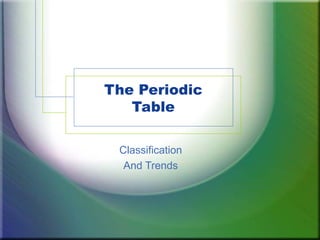
The periodic table classification
- 1. The Periodic Table Classification And Trends
- 2. The s-, p-, d-, and – f block Elements
- 4. s-Block Elements Group-1 Alkali Metals • Includes_________________ but not ____. Li, Na, K, Rb, Cs, Fr H X • end with _____ s1 • Li: 1s22s1 Na: 1s22s22p63s1 Example:______________________________ • soft These are all ______ metals (can be cut with a knife) • They are SO REACTIVE they are not found in free elements nature as _____ _________ but always in NaCl compounds ex. ______ air • So Reactive they often react with _____ and water ________ !!!! halogens • React strongly with ____________ (chlorine)
- 5. s-Block Elements Group 2 – Alkaline Earth Metals • Be, Mg, Ca, Sr, Ba, Ra Includes:_________________________ • Ends with ____ s2 • Mg 1s22s22p63s2 Ca 4s2 Ex:______________________________ • stronger denser harder __________, __________, __________, than Alkali Metals • Still ____ _________ to be found as free too reactive elements compounds • Always in ___________ ex. CaCo3 (Calcium Carbonate – “Limestone”)
- 7. d-Block Elements Transition Metals • Includes Groups ___ - ___ 3 12 • Ex.______________________________ gold, iron, silver, nickel, copper • ________ metals, ______ reactive typical less • gold platinum Some not reactive at all: ______, ________, and ____________ - have never been found palladium in compound colorful • Compounds are __________!! (ex. CuSO4 – Copper Sulfate – blue) s • Outer sublevel are __ and __ d [Ar] 4s23d8 • Ex. Nickel __________________
- 9. p-Block Elements • 3 categories: – ________ metals – non-metals ____________ – metalloids _________ • End with ___ and ___ sublevels s p 1s22s22p63s23p5 • Ex. Chlorine____________
- 10. Halogens (Group 17 (7A)) • Includes: _______________________ F, Cl, Br, I, (At) • most ________ non-metals active • react with metals to form _______ salt NaCl ex. _________ • 1 electron _________ of stable noble short gas notation, so usually gain 1 electron 1- ion to make _________ (ex. Cl-)
- 11. Metalloids X
- 12. Metalloids • along __________________ (not Al) zig-zag line / staircase B, Si, Ge, As, Sb, Te, Po, (At) • includes: ________________________ • both metal and non-metal properties
- 14. f-Block Elements • Period 6: Lanthanides shiny – _______ metals like alkaline earth metals – ex. Cerium • Period 7: Actinides radioactive – ALL are ____________ - no known stable isotopes!!!! Uranium plutonium – ex. __________, ___________
- 15. Valence Electrons Trends in the Periodic Table
- 16. Valence Electrons • These are the _________electrons, and the outer most electrons available to be _______ or ______ gained lost in chemical compounds • The presence of ______ valence electrons is 8 chemically ______ stable • Elements tend to react to acquire the stable electron structure of a ___________. noble gas
- 17. IONS • An atom or group of bonded positive atoms with a _____________ or ___________ charge. negative
- 18. Positive Ions • Are called ___________ CATIONS • They form when an atom LOSES ____________ electrons. • Example: Sodium Protons: 11+ Electrons: 10- Na 1+ ion
- 19. Negative Ions • Are called _________. ANIONS • They form when an atom GAINS _______ electrons. • Example: Chlorine Protons: 17+ Electrons: 18- Na 1- ion
- 20. How are ions formed?
- 21. Electron Dot Structure • Consists of the element’s ________ and ____ symbol dots representing the atom’s VALENCE electrons. • Ex. Na Cl
- 22. Valence electron periodic trends Electron Valence Ion Group Example Dot Electrons Tendency Structure 1 (1A) 1 1+ Na+ Na 2 (2A) 2 2+ Ca2+ Ca 13 (3A) 3 3+ Al3+ Al 14 (4A) 4 C P 15 (5A) 5 3- P3- 16 (6A) 6 2- O2- O 17 (7A) 7 1- Cl- Cl 18 (8A) 8 stable Ne
- 23. Questions??? • What is the electron dot structure for b) Sulfur? b) Magnesium?
- 24. Questions??? • How many valence electrons do the following elements have? b) Silicon? 4 e) Oxygen? 6
- 25. Questions??? • Predict the ion for b) Aluminum? Al3+ e) Strontium? Sr2+
- 26. Questions??? • Do the following elements typically gain or lose electrons? b) Fluorine? It’s a non-metal So…. GAINS 1 e) Cesium? It’s a metal so…. LOSES 1